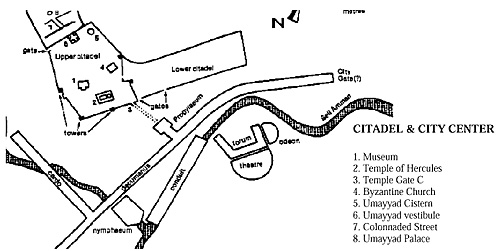The Hashemite Kingdom of Jordan is not considered by many persons to be their first choice for a vacation stop. However, everyone with an interest in history -- military and otherwise should visit there. In addition to the usual stops at the Dead Sea, Mount Nebo (the legendary burial place of Moses) and the most magical place on earth --Petra ("the rose-red city half as old as time") there are a number of other intriguing historical sites within the city of Amman enough to sate the most enthusiastic military history buff.
One such site is the Citadel of Amman -- el-Qal'a in Arabic. Perched atop the highest point in Amman, the Citadel has served as the center of Amman's religious, administrative and social life since the Bronze Age. The first thing you see are the defensive walls around it, most dating from the Roman, Byzantine and Ummayad-Abassid occupations (63 BC - AD 800). Other excavations have uncovered remains from the Hellenistic, Iron and Middle Bronze Ages.
The walls are built of well dressed limestone blocks ranging in thickness from 1-4 ards. Because of the constant building, rebuilding and redesigning, as well as the length of use the existing walls are now 1700 yards in length with ten towers and three gates. The Umayyad fortification walls are one of the few remaining examples in the world.
The Citadel is built in three tiers. The middle citadel is comprised of the parking lot (probably not a Roman construction) and the Temple of Hercules. The middle and upper tiers formed the Acropolis of the ancient city and accommodated the most important public monuments, among them was The Temple of Hercules was dedicated to Marcus Aurelius (Emperor 161-180 AD). The Temple is currently being reconstructed to its original appearance with new stone being fitted in with the older remaining stone. In its heyday it was connected with the city forum at the foot of the Citadel through a monumental staircase which has since vanished.
Atop the Citadel are also the rather unimpressive remnants of a Byzantine Church and a cistern. Nearby them is an Ummayad structure believed to have been a military and political center. All are interesting in their own way and in reasonable states of preservation for something fifteen hundred years old. My wife and I were about to leave the Citadel complex and start on our long trek downhill when we noticed that there was a place to get water by the Temple of Hercules. Actually it was a large Bedouin tent that also sold knick knacks and souvenirs. We went there and are extremely glad that we did. Not for the water but for the view of the city center and amphitheater below.
The amphitheater, discovered in 1950's, is cut into the side of a hill and was able to seat 6000. It was completed about 169 - 177 AD. Vaulted passageways provided access into the theater. The Ministry of Antiquities is attempting to reconstruct the theater and some of the nearby structures. As a result stonecutters are adding missing stone blocks along the contours set at the top of the theater. Next to the theater is the Forum -- the marketplace and main public square that marked all Roman cities. The Odeon --a smaller (500 seat) public theater and the Nymphaeum (public bath) are nearby. The Odeon is also a site of intense reconstruction and was closed when we visited.
There are two museums occupying what I guess would have been the old locker rooms of the amphitheater (which by the way still puts on performances). One of these is the Museum of Folklore and the other the Museum of Popular Tradition and Jewelry. They are closed on Tuesday. But to be honest, even when they are open, it takes an effort to actually say they are worth the visit.
Getting There
Several major airlines fly to Amman from the US, including Royal Jordanian, British Airways and KLM. Costs vary depending on your point of origin. As of this writing, entry into Jordan by US passport holders is fairly simple. Visas are issued at the airport free of charge and are good for two weeks. Departure requires payment of a 10 JD (approximately $14) airport tax. Potential visitors should check with both their local health departments and/or the Jordanian Embassy in their country regarding both health and visa requirements as these change without notice.
Make sure to allow sufficient time to visit Petra and Jerash (a city of the Decapolis). Because of Amman's height the city can be quite cool and downright cold in the fall, spring and winter. Petra and other points lower than Amman can be much warmer.

Back to Cry Havoc #2 Table of Contents
Back to Cry Havoc List of Issues
Back to MagWeb Master Magazine List
© Copyright 1993 by David W. Tschanz.
This article appears in MagWeb (Magazine Web) on the Internet World Wide Web. Other military history articles and gaming articles are available at http://www.magweb.com